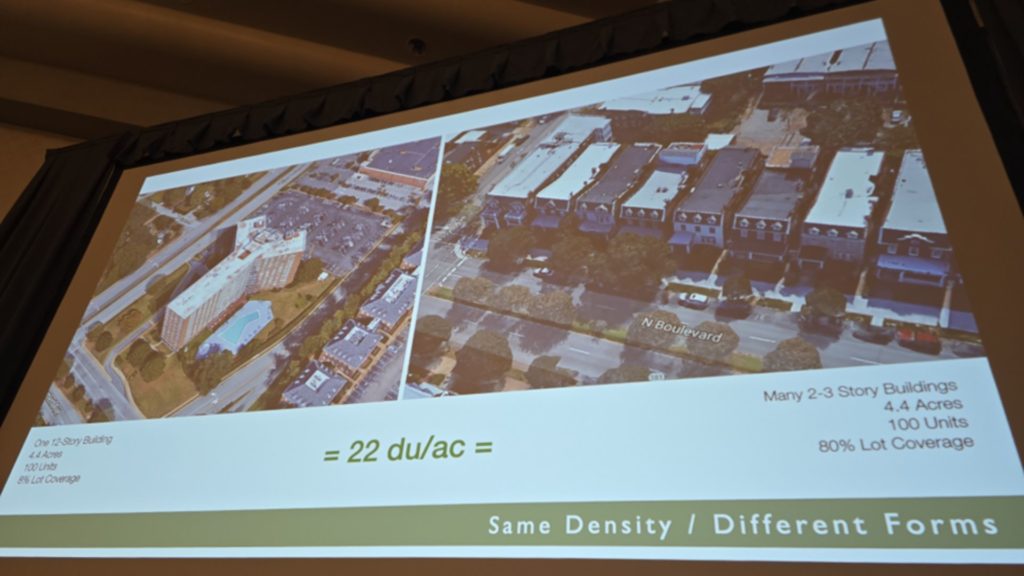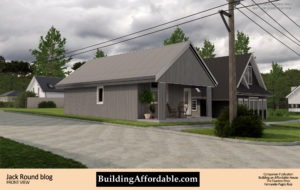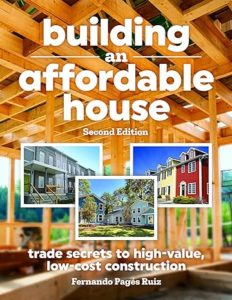Transit-oriented development – Density Matters
Density isn’t just a number—it’s the core framework behind everything that makes a city functional. From transit and schools to housing and climate goals, density matters more than building height or form. At CNU 33, urban planners David Dixon, Laurie Volk, and Marina Khoury emphasized that density is not about aesthetics—it’s about economic and social viability. Without enough people per square kilometer, neighborhoods can’t support local stores, functional schools, or public transit. Simply put, cities won’t work.
Density Matters: It’s Not About Tall Buildings
Many assume density means skyscrapers. But during the session, a 12-story tower was shown next to a row of 2- to 3-story homes—both delivering the same 22 units per acre. The takeaway: it’s not about height. It’s about how many households fit within a neighborhood. Whether it’s townhouses or apartments, density matters because it allows places to thrive. Transit, businesses, and even basic infrastructure all require a population threshold to be viable. That threshold varies by region, but the principle remains the same—without enough people in one area, systems break down.
Density Depends on Perspective
There’s no universal formula for transit-oriented development. Instead, different groups define “good density” differently:
Planners want transit-supported zones.
Cities need tax revenue to cover infrastructure.
Developers look for financial return.
Activists push either for change (YIMBY) or against it (NIMBY).
Density matters only when the goal is clearly defined. Whether optimizing for transportation, affordability, or sustainability, clarity in purpose shapes productive land use.
The 1/3–1/3–1/3 Rule: A Flexible Density Model
The most resilient neighborhoods offer one-third single-family homes, one-third townhomes, and one-third multifamily buildings. This blend creates:
Housing options for different incomes and life stages
Affordability without relying on subsidies
Adaptability during market shifts
This mixed-density model—when paired with walkable street grids—allows communities to grow incrementally without demolishing and rebuilding whole blocks. It also minimizes risk and increases long-term value.
Why Cities Can’t Afford Low Density
Municipal budgets depend on property tax. Sprawling suburbs cost more to maintain (think: roads, sewers, power lines) but produce less revenue. One analysis from Strong Towns showed that, in 1949, neighborhoods had more residents, generated higher taxes, and required less infrastructure than they do today. Suburban growth didn’t pay off.
In contrast, high-density multifamily projects can generate over $17 million per acre in tax revenue. Compare that to $1.5 million from suburban commercial lots. The conclusion is blunt: density matters because it pays for itself—sprawl does not.
Schools Can’t Function Without Density
Want thriving neighborhood schools? You need families—and enough of them. One modeled community, with 1,400 households spread over 200 acres, could support schools at all grade levels. Without that population, schools either close or require long commutes. Land use is school policy. Density matters when it comes to building educational opportunity.
Parking: The Hidden Density Killer
One parking space cuts potential residential units by 25%. Two spaces? That takes up more area than a two-bedroom apartment. In downtown Providence, parking lots eat up 27% of land. Not only does this hurt housing supply, but it also:
Increases housing costs by $10,000 to $33,000 per stall
Reduces walkability
Raises emissions
Cities that prioritize parking over people won’t solve their housing crisis. Density matters only when zoning codes align with human needs—not car storage.
A Path Forward: Reform That Unlocks Density
Florida’s Live Local Act offers a real policy example. Through Senate Bill 102, the state relaxed zoning rules and provided incentives to develop affordable housing—even on commercially zoned land. This lets communities meet housing needs where jobs already exist.
In tandem, proposals like the updated single-stair code (allowing up to six stories with a single egress stair) open the door for building on small, irregular urban lots. These reforms allow more infill development without massive overhauls, proving that density matters most when backed by smart legislation.
Transit-oriented development – It’s Foundational
Every major urban goal—walkability, school access, climate resilience, economic health—starts with density. It’s not just about how we build, but why. Without density, policies fail, infrastructure wastes, and cities become unaffordable.
Density matters because it underpins everything that makes city life work. It’s time to stop treating it like a design preference and start treating it as a necessity.
Read: Single-Stair Multifamily Housing for the I-95 Corridor and Beyond





